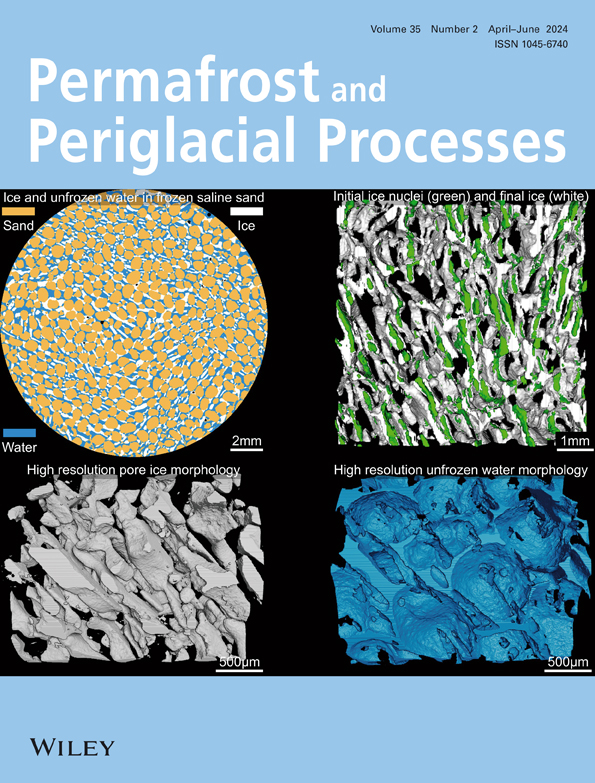Distribution, morphometry, and ice content of ice‐wedge polygons in Tombstone Territorial Park, central Yukon, Canada
IF 3.3
3区 地球科学
Q2 GEOGRAPHY, PHYSICAL
引用次数: 7
Abstract
Investigations of the regional distribution of ice‐wedge polygons and wedge‐ice volume allow for the assessment of the vulnerability of permafrost landscapes to thaw‐induced disturbances and related ecological feedbacks. Ice‐wedge polygons have been described in multiple studies in flat terrain and low‐gradient hillslopes, but few studies have examined ice‐wedge polygons in mountainous terrain. This study investigates the distribution, morphometry, and wedge‐ice content of ice‐wedge polygons in Tombstone Territorial Park, a mountainous permafrost region in central Yukon. Results show that ice‐wedge polygons occupy 2.6% of the park and preferentially develop in woody sedge peat, glaciofluvial, and alluvial deposits along the lower reaches of the Blackstone and East Blackstone rivers on hillslopes ≤1°. The morphometry of five of six polygonal sites studied showed statistically similar polygon sizes and trough angles, while showing different development stages based on vegetation type, surface wetness, and spatial pattern. The estimation of wedge‐ice volumes in the ice‐wedge polygons is 8–22% and is comparable to that of other Arctic regions. However, the estimated wedge‐ice volume represents a minimum value because older generations of ice wedges are truncated 3–4 m below the surface with no evidence of surface polygons, and the polygonal network can be obscured by slope processes, vegetation, and ice‐wedge inactivity. This study provides insights into the application of morphometric and soil parameters for the assessment of ice‐wedge polygon distribution and development stages.加拿大育空地区中部Tombstone地区公园冰楔多边形的分布、形态计量和含冰量
对冰楔多边形和冰楔体积的区域分布进行调查,可以评估永久冻土景观对融化引起的扰动和相关生态反馈的脆弱性。在平坦地形和低坡度山坡的多项研究中,已经描述了冰楔多边形,但很少有研究对山区的冰楔多边形进行研究。本研究调查了育空地区中部山区永久冻土区Tombstone Territorial Park冰楔多边形的分布、形态计量和楔冰含量。结果表明,冰楔多边形占据了公园的2.6%,并优先在≤1°的山坡上沿黑石河和东黑石河下游的木本莎草泥炭、冰川河流和冲积层中发育。所研究的六个多边形站点中,有五个站点的形态计量显示出统计上相似的多边形大小和槽角,同时根据植被类型、表面湿度和空间模式显示出不同的发展阶段。冰楔多边形中楔冰体积的估计值为8-22%,与其他北极地区相当。然而,估计的冰楔体积代表了一个最小值,因为老一辈的冰楔在地表以下3-4米处被截断,没有表面多边形的证据,并且多边形网络可能会被斜坡过程、植被和冰楔不活动所掩盖。本研究深入了解了形态计量学和土壤参数在评估冰楔多边形分布和发育阶段中的应用。
本文章由计算机程序翻译,如有差异,请以英文原文为准。
求助全文
约1分钟内获得全文
求助全文
来源期刊
CiteScore
9.70
自引率
8.00%
发文量
43
审稿时长
>12 weeks
期刊介绍:
Permafrost and Periglacial Processes is an international journal dedicated to the rapid publication of scientific and technical papers concerned with earth surface cryogenic processes, landforms and sediments present in a variety of (Sub) Arctic, Antarctic and High Mountain environments. It provides an efficient vehicle of communication amongst those with an interest in the cold, non-glacial geosciences. The focus is on (1) original research based on geomorphological, hydrological, sedimentological, geotechnical and engineering aspects of these areas and (2) original research carried out upon relict features where the objective has been to reconstruct the nature of the processes and/or palaeoenvironments which gave rise to these features, as opposed to purely stratigraphical considerations. The journal also publishes short communications, reviews, discussions and book reviews. The high scientific standard, interdisciplinary character and worldwide representation of PPP are maintained by regional editorial support and a rigorous refereeing system.

 求助内容:
求助内容: 应助结果提醒方式:
应助结果提醒方式:


